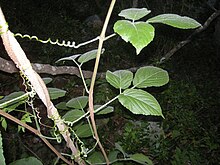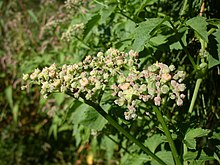Cayratia
| Cayratia | ||||||||||||
|---|---|---|---|---|---|---|---|---|---|---|---|---|

|
||||||||||||
| Systematics | ||||||||||||
|
||||||||||||
| Scientific name | ||||||||||||
| Cayratia | ||||||||||||
| Yuss. |
Cayratia is a genus of plants within the grapevine family(Vitaceae). The 45 to 60 species arewidespreadin the Old World .
description



Appearance and leaves
In cayratia TYPES rarely are perennial herbaceous plants or mostly little to more woody plants that independently upright as shrubs or climbing as lianas grow. They can be evergreen or deciduous. The shoot tendrils opposite the leaves are branched with two, three or more bifurcations and their ends sometimes have adhesive discs.
There are cayratia species with heterophyllia . The alternate and two lines or spirally arranged on the stem axis leaves are usually divided into petiole and leaf blade. Depending on the species, the leaf blade is divided into three to nine hands or pinnate in the shape of a foot. In the case of hand-shaped spreaders, the lateral leaf sections are often smaller than the end sections. The leaf margins are notched or serrated. The leaf surfaces are often dotted with glands. The nerves are mostly hand-nerved, rarely pinnate, and the network nerves can also be recognizable. The stipules fall off early.
Inflorescences and flowers
Cayratia species are either polygamous-monoecious , but mostly monoecious, separate sexes ( monoecious ), so the flowers of both sexes are on one specimen, but sometimes hermaphroditic flowers are also found; or all flowers are hermaphroditic. The lateral, mostly on a long inflorescence stem, zymous inflorescences are compound dichasias or polychasias and usually contain many flowers. There are bracts , bracts and flower stalks.
The relatively small flowers are fourfold and radial symmetry with a double flower envelope . The four bare sepals are cup-shaped over mostly their entire length and calyx teeth are at most very short. The four free, spread out petals can be somewhat hood-shaped at the top and fall off individually. The well-developed, cup-shaped disc has a wavy or slightly four-lobed edge and is fused with the base of the ovary. There is only the inner circle of the stamen with four fertile, identical, free stamens . The two carpels are an above-permanent, two-chambered ovary grown. There are only two ovules per ovary chamber . The short, pencil-shaped stylus ends in a relatively small scar, which can enlarge somewhat after the anthesis .
Fruits and seeds
The more or less spherical berries are fleshy and usually contain only one to four seeds. The seeds are triangular to ovoid. The oil-containing endosperm is almost circular or T-shaped in cross section. The straight embryo has two germ layers ( cotyledons ).
Systematics and distribution
The first publication of cayratia was carried out in 1818 by de Antoine-Laurent Jussieu in F. Cuvier: Dictionnaire des Sciences Naturelles , 2nd Edition, Volume 10, p 103. Type species is cayratia pedata (Lour.) Juss. Cayratia Juss. nom. cons. is preserved in accordance with the ICBN rules (Vienna ICBN Art. 14.4 & App. III) compared to Lagenula Lour. nom. rej. A synonym for Cayratia Juss. is Columella Lour. According to Genaust (1996), the origin of the generic name Cayratia is unclear.
The genus Cayratia belongs to the subfamily Vitoideae within the Vitaceae family. Cayratia pedata
The wide natural range of the genus Cayratia includes Asia and Australia , New Caledonia , Africa , Madagascar , Malesia and Oceania . There are 17 species in China, nine of them only there. About eight species are native to Australia, five of them only there.
There are 45 to 60 Cayratia species, here the species found in China, Madagascar and Australia:
- Cayratia acris (F.Muell.) Domin : It occurs in Australia and Papua New Guinea .
- Cayratia albifolia C.L.Li : It occurs in China.
- Cayratia cardiophylla Jackes : It occurs in Australia.
- Cayratia cardiospermoides (Planch. Ex Franchet) Gagnep. : It occurs in Sichuan and Yunnan .
- Cayratia ciliifera (Merr.) Chun : It occurs in Vietnam and in Hainan .
- Cayratia clematidea (F.Muell.) Domin : It occurs in Australia.
- Cayratia cordifolia C.Y.Wu ex CLLi : It occurs in Yunnan.
- Cayratia corniculata (Benth.) Gagnep. : It occurs in Malaysia , the Philippines , Vietnam, Taiwan and China.
- Cayratia daliensis C.L.Li : It occurs in Yunnan.
- Cayratia eurynema B.L.Burtt : It occurs in Australia.
- Cayratia fugongensis C.L.Li : It occurs in Yunnan.
- Cayratia geniculata (flower) Gagnep. : It occurs in China, Indonesia , Laos , Malaysia, the Philippines and Vietnam.
- Cayratia gracilis (Guill. & Perr.) Suess. : It is widespread in Africa.
- Cayratia imerinensis (Baker) Desc. : It occurs in Madagascar and the Comoros .
- Cayratia japonica (Thunb.) Gagnep. : It iswidespreadin India , Bhutan , Nepal, Myanmar , Thailand , Laos, Korea, Vietnam, China, Taiwan, Japan , Malaysia, Indonesia, the Philippines and Australia. It comes in three varieties.
- Cayratia lanceolata (CLLi) J.Wen & ZDChen : It occurs in Hainan .
- Cayratia longiflora Desc. : It only occurs in Madagascar.
- Cayratia maritima Jackes : It occurs on the coasts of Australia and Taiwan.
- Cayratia medogensis C.L.Li : It occurs in Tibet .
- Cayratia menglaensis C.L.Li : It occurs in Yunnan.
- Cayratia oligocarpa (H.Lév. & Vaniot) Gagnep. : It occurs in China.
- Cayratia pedata (Lour.) Juss. : It occurs in China, Cambodia , India, Indonesia, Malaysia, Thailand and Vietnam.
- Cayratia saponaria (Seem. Ex Benth.) Domin : It occurs only in the Australian state of Queensland .
- Cayratia timoriensis (DC.) CLLi : It occurs in Indonesia, Malaysia, Thailand and Yunnan. It includes two varieties.
- Cayratia trifolia (L.) Domin (Syn .: Columella trifolia (L.) Merr. , Cissus trifolia (L.) K.Schum. , Vitis trifolia L. , Cissus psoraliifolia (F.Muell.) Planch. , Cissus crenata Vahl , Cissus obtusifolia Poir. , Vitis psoraliifolia F. Muell. , Vitis psoralifolia F. Muell. Orth. Var., Cissus psoralifolia Planch. Orth. Var., Cayratia carnosa (Lam.) Gagnep. , Cissus carnosa Lam. , Cissus acutifolia Poir . , Cissus cinerea Lam. ): It iswidespreadfrom India, Bangladesh , Nepal, Thailand, Laos, Cambodia, Yunnan, Vietnam, Malaysia through Indonesia to Australia.
- Cayratia triternata (Baker) Desc. : It only occurs in Madagascar.
use
In some African countries, the leaves of Cayratia gracilis in particular are usually eaten cooked, and subterranean parts of the plant are more rarely used as food.
swell
- Hui Ren, Jun Wen: Cayratia , p. 189 - the same text online as the printed work , In: Wu Zheng-yi, Peter H. Raven, Deyuan Hong (ed.): Flora of China , Volume 12 - Hippocastanaceae through Theaceae , Science Press and Missouri Botanical Garden Press, Beijing and St. Louis 2007, ISBN 978-1-930723-64-1 .
- HR Coleman, 2008: Entry in the Western Australian flora .
- Anna Trias-Blasi, John AN Parnell, Trevor R. Hodkinson: Multi-gene Region Phylogenetic Analysis of the Grape Family (Vitaceae). In: Systematic Botany , Volume 37, Issue 4, 2012, pp. 941-950. doi : 10.1600 / 036364412X656437
Individual evidence
- ^ A b c d e f C. Gardner, TA James: Cayratia in the New South Wales Flora Online .
- ↑ a b c d e f g h i j k l m n o p q r s t u v Hui Ren, Jun Wen: Cayratia , p. 189 - online with the same text as the printed work , In: Wu Zheng-yi, Peter H Raven & Deyuan Hong (Eds.): Flora of China , Volume 12 - Hippocastanaceae through Theaceae , Science Press and Missouri Botanical Garden Press, Beijing and St. Louis 2007, ISBN 978-1-930723-64-1 .
- ↑ a b c d e HR Coleman, 2008: Entry in the Western Australian Flora .
- ^ Anna Trias-Blasi, John AN Parnell & Trevor R. Hodkinson: Multi-gene Region Phylogenetic Analysis of the Grape Family (Vitaceae) , In: Systematic Botany , Volume 37, Issue 4, 2012, pp. 941-950. doi : 10.1600 / 036364412X656437
- ↑ Cayratia at Tropicos.org. Missouri Botanical Garden, St. Louis, accessed July 7, 2013.
- ^ A b c Cayratia in the Germplasm Resources Information Network (GRIN), USDA , ARS , National Genetic Resources Program. National Germplasm Resources Laboratory, Beltsville, Maryland. Retrieved March 1, 2017.
- ↑ Helmut Genaust: Etymological dictionary of botanical plant names. 3rd, completely revised and expanded edition. Birkhäuser, Basel / Boston / Berlin 1996, ISBN 3-7643-2390-6 Google-Book. .
- ↑ Enter the taxon in the search mask for Australian Plant Name Index = APNI. ( Memento of the original from August 11, 2010 in the Internet Archive ) Info: The archive link was inserted automatically and has not yet been checked. Please check the original and archive link according to the instructions and then remove this notice.
- ↑ a b c Cayratia in the Madagascar Catalog .
- ↑ Gerardus JH Grubben (Ed.): Vegetables in Plant resources of tropical Africa , Volume 2, PROTA-Verlag, 2004. ISBN 978-90-5782-147-9 : Google-Books-online. , Cayratia species therein, pages 166–167.
further reading
- Maurizio Rossettoac, Betsy R. Jackesb, Kirsten D. Scotta, Robert J. Henry: Is the genus Cissus (Vitaceae) monophyletic? Evidence from plastid and nuclear ribosomal DNA. In: Systematic Botany , 27, Issue 3, 2002, pp. 522-533. on-line.
